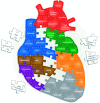Emerging biomarkers for evaluating cardiovascular risk in the chronic kidney disease patient: how do new pieces fit into the uremic puzzle?
- PMID: 18184879
- PMCID: PMC6631093
- DOI: 10.2215/CJN.03670807
Emerging biomarkers for evaluating cardiovascular risk in the chronic kidney disease patient: how do new pieces fit into the uremic puzzle?
Abstract
Premature cardiovascular disease (CVD), including stroke, peripheral vascular disease, sudden death, coronary artery disease, and congestive heart failure, is a notorious problem in patients with chronic kidney disease (CKD). Because the presence of CVD is independently associated with kidney function decline, it appears that the relationship between CKD and CVD is reciprocal or bidirectional, and that it is this association that leads to the vicious circle contributing to premature death. As randomized, placebo-controlled trials have so far been disappointing and unable to show a survival benefit of various treatment strategies, such a lipid-lowering, increased dialysis dose and normalization of hemoglobin, the risk factor profile seems to be different in CKD compared with the general population. Indeed, seemingly paradoxical associations between traditional risk factors and cardiovascular outcome in patients with advanced CKD have complicated our efforts to identify the real cardiovascular culprits. This review focuses on the many new pieces that need to be fit into the complicated puzzle of uremic vascular disease, including persistent inflammation, endothelial dysfunction, oxidative stress, and vascular ossification. Each of these is not only highly prevalent in CKD but also more strongly linked to CVD in these patients than in the general population. However, a causal relationship between these new markers and CVD in CKD patients remains to be established. Finally, two novel disciplines, proteomics and epigenetics, will be discussed, because these tools may be helpful in the understanding of the discussed vascular risk factors.
Figures




Similar articles
-
Vascular disease and chronic renal failure: new insights.Neth J Med. 2010 Jan;68(1):5-14. Neth J Med. 2010. PMID: 20103816 Review.
-
Protecting the endothelium: a new focus for management of chronic kidney disease.Hemodial Int. 2006 Jan;10(1):42-8. doi: 10.1111/j.1542-4758.2006.01173.x. Hemodial Int. 2006. PMID: 16441826
-
Biomarkers determining cardiovascular risk in patients with kidney disease.Curr Med Chem. 2012;19(16):2555-71. doi: 10.2174/092986712800492986. Curr Med Chem. 2012. PMID: 22489717 Review.
-
Clinical epidemiology of cardiovascular disease in chronic kidney disease prior to dialysis.Semin Dial. 2003 Mar-Apr;16(2):101-5. doi: 10.1046/j.1525-139x.2003.16025.x. Semin Dial. 2003. PMID: 12641872 Review.
-
Biomarkers in hemodialysis patients.Adv Clin Chem. 2012;57:29-56. doi: 10.1016/b978-0-12-394384-2.00002-4. Adv Clin Chem. 2012. PMID: 22870586 Review.
Cited by
-
Relapsing Calciphylaxis of the Breast: Glucocorticoids - Friend or Foe?Indian J Nephrol. 2024 Sep-Oct;34(5):522-523. doi: 10.4103/ijn.ijn_201_23. Epub 2023 Sep 29. Indian J Nephrol. 2024. PMID: 39372626 Free PMC article.
-
Associations between Thyroid Hormones, Calcification Inhibitor Levels and Vascular Calcification in End-Stage Renal Disease.PLoS One. 2015 Jul 6;10(7):e0132353. doi: 10.1371/journal.pone.0132353. eCollection 2015. PLoS One. 2015. PMID: 26147960 Free PMC article.
-
Lipoprotein profile, lipoprotein-associated phospholipase A2 and cardiovascular risk in hemodialysis patients.J Nephrol. 2015 Dec;28(6):749-55. doi: 10.1007/s40620-015-0194-0. Epub 2015 May 14. J Nephrol. 2015. PMID: 25971848
-
Association between albuminuria, kidney function, and inflammatory biomarker profile in CKD in CRIC.Clin J Am Soc Nephrol. 2012 Dec;7(12):1938-46. doi: 10.2215/CJN.03500412. Epub 2012 Sep 27. Clin J Am Soc Nephrol. 2012. PMID: 23024164 Free PMC article.
-
Lipid and nutritional profiles of Caribbean patients with chronic kidney disease.Afr Health Sci. 2023 Sep;23(3):645-654. doi: 10.4314/ahs.v23i3.75. Afr Health Sci. 2023. PMID: 38357113 Free PMC article.
References
-
- Foley RN, Parfrey PS, Sarnak MJ: Clinical epidemiology of cardiovascular disease in chronic renal failure. Am J Kidney Dis 32 [Suppl 5]: S112–S119, 1998 - PubMed
-
- Eknoyan G, Beck GJ, Cheung AK, Daugirdas JT, Greene T, Kusek JW, Allon M, Bailey J, Delmez JA, Depner TA, Dwyer JT, Levey AS, Levin NW, Milford E, Ornt DB, Rocco MV, Schulman G, Schwab SJ, Teehan BP, Toto R: Effect of dialysis dose and membrane flux in maintenance hemodialysis. N Engl J Med 347: 2010–2019, 2002 - PubMed
-
- Paniagua R, Amato D, Vonesh E, Correa-Rotter R, Ramos A, Moran J, Mujais S: Effects of increased peritoneal clearances on mortality rates in peritoneal dialysis: ADEMEX, a prospective, randomized, controlled trial. J Am Soc Nephrol 13: 1307–1320, 2002 - PubMed
-
- Cano NJ, Fouque D, Roth H, Aparicio M, Azar R, Canaud B, Chauveau P, Combe C, Laville M, Leverve XM: Intradialytic parenteral nutrition does not improve survival in malnourished hemodialysis patients: A 2-year multicenter, prospective, randomized study. J Am Soc Nephrol 18: 2583– 2591, 2007 - PubMed
-
- Jamison RL, Hartigan P, Kaufman JS, Goldfarb DS, Warren SR, Guarino PD, Gaziano JM: Effect of homocysteine lowering on mortality and vascular disease in advanced chronic kidney disease and end-stage renal disease. JAMA 10: 1163–1170, 2007 - PubMed
Publication types
MeSH terms
Substances
LinkOut - more resources
Full Text Sources
Other Literature Sources
Medical
Research Materials

